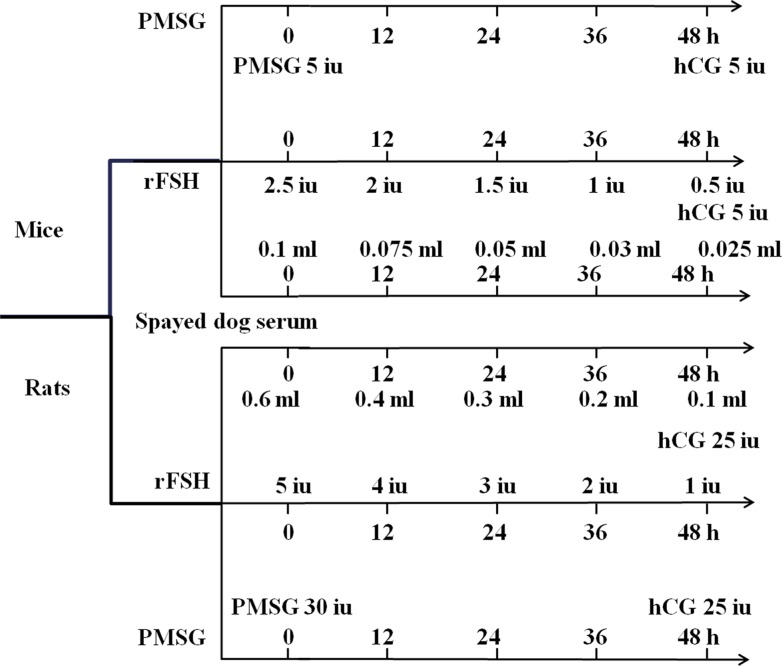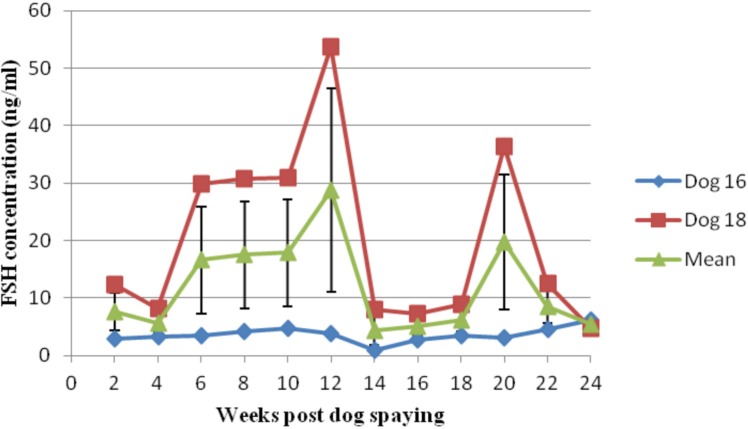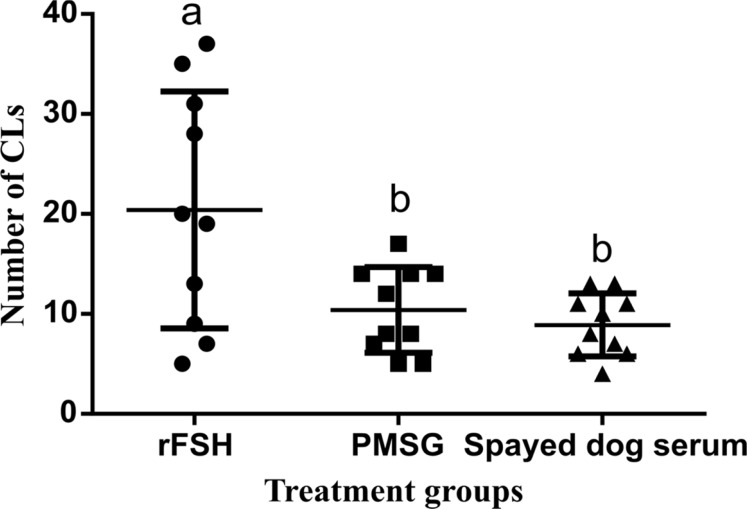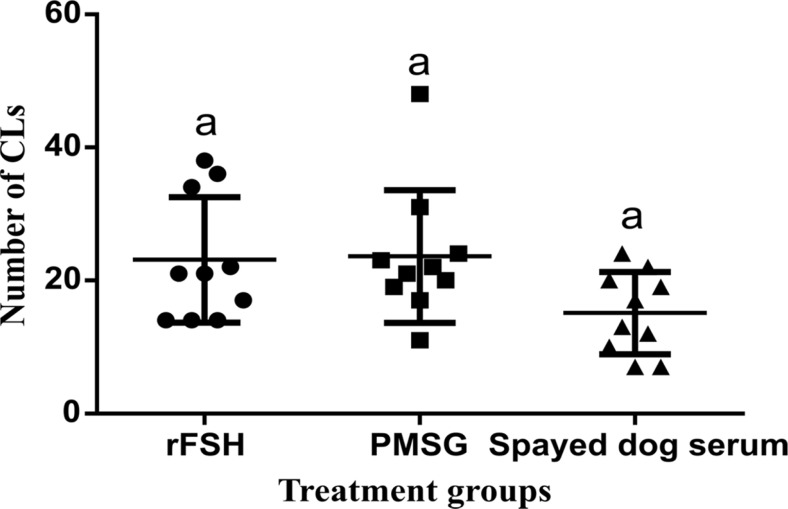Abstract
The following experiments were designed to examine the effect of serum of spayed dogs on superovulation response in mice and rats. In Experiment 1, female mice at diestrus (n=30) were divided into three equal groups and superovulated with either administration of 5 IU pregnant mare serum gonadotropin (PMSG) or recombinant follicle stimulating hormone (rFSH) (reducing dose from 2.5 to 0.5 IU) and 5 IU human chorionic gonadotropin (hCG) administered 48h later. Serum of spayed dogs was administered intraperitoneally at a reduced dose from 0.1 to 0.025 mL in a 48 h period. In Experiment 2, female rats (n=30) at diestrus stage were divided into three equal groups. Superovulation was induced using either 30 IU PMSG, or a dose reduced from 5 to 1 IU rFSH and 25 IU hCG administered 48h later. Serum of spayed dogs was administered in a reduced dose from 0.6 to 0.1 mL in a 48 hour period. Female mice and rats were mated 24 h following hCG administration. On day 14 after mating, animals were euthanized and ovarian sections were fixed for histopathological evaluation and corpus luteum (CL) counting. No significant difference observed in mean (±SEM) number of CLs between the PMSG group and the mice that received serum of spayed dog (10.4±1.3 vs 9.2±1.0). Mean (±SEM) number of CLs tended to be lower in rats that received serum of spayed dog than those of rats which received either PMSG or rFSH (15.1±1.9 vs 23.6±3.1 and 23.1±2.9, P=0.06, respectively). In conclusion, serum of spayed dogs is able to induce a superovulatory response in mice and rats.
There are many different superovulation protocols using various hormones in a wide variety of animal species. Pregnant mare's serum gonadotropin (PMSG, also called equine chorionic gonadotropin), follicle stimulating hormone (FSH) preparations and human menopausal gonadotropin (hMG) are the most common gonadotropins that have been extensively used for induction of superovulation. The source, availability, as well as the efficiency of each product has always been a concern for reproduction clinicians as well as researchers. The efficiency of these products depends on species, time, dosage and FSH/LH ratio [37]. In rats and mice, strain, weight (or age) and dosage schedule influence the response to superovulatory hormones [1011]. In addition to the above-mentioned hormonal preparations, immune-neutralization of endogenous inhibin [6], administration of inhibin antiserum with or without PMSG [15] and inhibin antiserum with progesterone presynchronization [4] protocols have also been used in rats and mice.
Synthesis and release of FSH are under the control of the negative and positive feedback of ovarian steroids, mainly estrogens and progesterone. In both males and females, mean basal plasma LH and FSH concentrations increase after gonadectomy, due to loss of negative feedback of gonadal hormones [78]. When the effect of negative feedback is removed or attenuated from the hypothalamus and pituitary, FSH concentration significantly increases to a surge level. This may also occur in physiological conditions such as menopause [16] or be induced by ovariectomy or ovario-hysterectomy [12]. Serum and urine of menopausal women contain a large amount of FSH which is extracted and purified as a commercial product named hMG. Female dogs are routinely spayed as a part of programs for management and control of their population [13]. After spaying, there would be no estrogen and progesterone feedback control on pituitary releasing hormones. Mean serum FSH concentration in ovario-hysterectomized bitches is higher than those sexually intact bitches [112]. Further, the concentration of FSH is higher in ovariectomized dogs (81.7 µg/L) than those of the anestrus dogs (5.6 µg/L) [2]. To our knowledge, there is no information on the use of serum of spayed female dogs for induction of superovulation. Our hypothesis was that FSH rich serum of spayed female dogs is a potent preparation for induction of superovulatory response in mice and rats. Therefore, the present experiments were designed to examine the effect of serum of spayed female dogs on superovulation response in mice (Experiment 1) and rats (Experiment 2).
This study was approved by the Iranian laboratory animal ethics framework under the supervision of the Iranian Society for the Prevention of Cruelty to Animals and Shiraz University Research Council (IACUC no: 4687/63).
Two healthy adult (1–2 years old) intact mixed breed female dogs were used in present study. Appropriate, standard food and antiparasitic drugs were given for at least 2 weeks before the commencement of the study. The dogs were then ovario-hysterectomized in anestrus phase under general anesthesia using the midline approach. One month after spaying and recovery of the animals, maximum available blood (based on 10% of their body weights) was collected using a catheter from the jugular vein. The blood was kept in separate collecting tubes (10 mL) and then immediately centrifuged at 3000 rpm for 10 min. Then serum was stored at −20℃. The volume of the collected serum was about 30% of the blood volume. Blood sampling was continued every two weeks for a 6 month period after spaying. Serum FSH concentration was determined using a commercial canine FSH Elisa kit with sensitivity of 0.028 ng/mL and assay range of 0.05 to 30 ng/mL (Shanghai Crystal Day Biotech Co., LTD). Serum samples were then pooled and used for induction of superovulation in mice and rats.
The laboratory animals were obtained from the Laboratory Animal Center of Shiraz University of Medical Sciences. As a routine program, the colony is strictly maintained by inbreeding. Males and females were separated before puberty at the age of 21 days. They were kept in special cages (27×21×14 cm) and suitable rooms (22℃, 40–60% humidity, 12 h light/12 h darkness) and fed with standard pelleted ration (Laboratory animal feed, Javaneh Khorasan, Iran). Female BALB/c mice, aged 6–8 weeks and fertile male mice 2–3 months old were used in Experiment 1. Male and female Sprague Dawley rats aged 10–12 weeks were also used in Experiment 2.
The protocols for induction of superovulation in mice and rats are shown in detail in Figure 1. In Experiment 1, female mice (n=30) at diestrus stage were divided into three equal groups. Superovulation was induced in group 1 (n=10) either by intraperitoneal administration of 5 IU PMSG (Pregnecol, Bioniche Animal Health, Australia) or in group 2 (n=10) rFSH (dose reduced from 2.5 to 0.5 IU, Fostimon, IBSA, Switzerland) and 5 IU human chorionic gonadotropin (hCG, DarouPakhsh, Iran) administered 48–50 h later. In group 3 (n=10), serum of spayed dogs was administered intraperitoneally at a dose reduced from 0.1 to 0.025 mL in a 48 h period according to experimental design (Figure 1). The amount of anestrus dog's serum was based on the equivalent volume of rFSH dose in group 2 (rFSH 2.5 IU=0.1 mL).
In Experiment 2, female rats (n=30) at diestrus stage were divided into three equal groups (n=10). Superovulation was induced using either 30 IU PMSG (Group 1; Pregnecol, Bioniche Animal Health, Australia), or a dose reduced from 5 to 1 IU rFSH (Group 2; Fostimon, IBSA, Switzerland) and then 25 IU hCG (DarouPakhsh, Iran) intraperitoneally. In group 3, serum of spayed dogs was administered intraperitoneally in a dose reduced from 0.6 to 0.1 mL according to experimental design in a 48 hour period (Figure 1). It should be noted again that the volume of anestrus dog's serum injection calculated was based on the equivalent volume of rFSH in group 2 (rFSH 5 IU=0.6 mL). Female mice and rats were mated with a ration 1:1 (female: male) 24 hours following hCG administration.
On day 14 after mating, animals were humanely euthanized with head dislocation under general anesthesia. Four sections of the ovary of each mouse or rat were fixed in 10% buffered formalin for histopathological evaluation using Hematoxylin-Eosin staining method. Ovarian sections were examined under a light microscope with objective magnification ×10 for counting the corpora lutea (CLs).
The results of two separate studies were analyzed using Graphpad Prism 6 program. One way ANOVA was used to compare the means of CLs among three groups and then Tukey's multiple comparisons were used to compare group by group. The results are reported as Mean±SEM and level of significance was set at P<0.05.
Serum concentrations of FSH in female spayed dogs during the six months sampling are shown in Figure 2. Individual variability as well as changes in the serum FSH concentration were observed during the sampling period. Mean (±SEM) serum FSH concentration in one of the spayed dogs was 3.59±0.36 (0.86–6.11) ng/mL while in another dog was 20.3±4.5 (4.8–53.7) ng/mL. Mean (±SEM) FSH concentration in the pooled serum samples was 11.9±2.8 (4.4–28.7) ng/mL.
In Experiment 1, there was a significant difference in mean (±SEM) number of CLs between rFSH group and the mice that received serum of spayed dog (20.4±3.7 vs 9.2±1.0; P=0.01). However, no significant difference was observed in mean (±SEM) number of CLs between the PMSG group and the mice that received serum of spayed dog (10.4±1.3 vs 9.2±1.0) (Figure 3). In addition, mice which received rFSH had a higher mean (±SEM) number of CLs than that of the PMSG group (P=0.01) on day 14 post-mating.
In Experiment 2, mean (±SEM) number of CLs was not significantly different among the experimental groups (P=0.06, Figure 4). Mean (±SEM) number of CLs tended to be lower in rats that received serum of spayed dog than those of rats which received either PMSG or rFSH (15.1±1.9 vs 23.6±3.1 and 23.1±2.9, P=0.06, respectively) on day 14 post-mating.
Results of the present experiments showed for the first time that serum collected from spayed female dogs is capable of inducing a superovulatory response in mice and rats. The mean number of CLs in mice that received serum of spayed dogs was similar to that of the PMSG group. Likewise, the serum of spayed dogs was able to induce a superovulatory response compared to the rats which received rFSH or PMSG. The reason for the lower superovulatory response in mice and rats that received serum of spayed dogs could be ascribed to the fact that we used a pooled serum preparation with low and high concentration of FSH. A more promising approach could be the collection of serum samples from a higher number of spayed dogs and then due to the presence of individual variations, only those with high amount of serum FSH are used for induction of superovulation. Alternatively, serum of spayed dogs could be purified and then used for superovulation.
Results of this experiment further showed the presence of the individual variability in serum FSH concentrations and changes over time in female spayed dogs. Extraction and potency of hormones with biological sources have encountered some clinical challenges including individual variability, pulsatile secretion and immune reactions [89]. Individual variation in gonadotropin secretary pattern have been reported in PMSG in mares [5], human menopausal gonadotropin [14] and FSH in dogs [1]. It is important to point out that amplitude, frequency and total concentration of hormones varies among individuals in each species and is affected by their age and body conditions.
In conclusion, serum preparation of spayed dogs is able to induce a superovulatory response in mice and rats. Superovulatory effect of serum of spayed dogs was comparable with PMSG in mice. The lower superovulatory response compared to that of the FSH group in rats could be ascribed to the presence of the individual variability in serum FSH concentrations and changes over time in female spayed dogs. More researches are required to determine the optimum conditions in spayed dogs for collection of serum samples with high FSH concentration.
Acknowledgments
The authors acknowledge Shiraz University for financially supporting this study (Grant number: 94GCU4M154630). We specically thank Mrs. Sheryl Nikpoor, the editor of scientic manuscripts of the Shiraz University, for her meticulous editing of our manuscript.
References
1. Albers-Wolthers CH, de Gier J, Oei CH, Schaefers-Okkens AC, Kooistra HS. Validation of a noninvasive diagnostic tool to verify neuter status in dogs: The urinary FSH to creatinine ratio. Theriogenology. 2016; 86(5):1376–1381. PMID: 27242177.

2. Beijerink NJ, Buijtels JJ, Okkens AC, Kooistra HS, Dieleman SJ. Basal and GnRH-induced secretion of FSH and LH in anestrous versus ovariectomized bitches. Theriogenology. 2007; 67(5):1039–1045. PMID: 17275081.

3. Boland MP, Goulding D, Roche JF. Alternative gonadotrophins for superovulation in cattle. Theriogenology. 1991; 35(1):5–17.

4. Hasegawa A, Mochida K, Inoue H, Noda Y, Endo T, Watanabe G, Ogura A. High-Yield Superovulation in Adult Mice by Anti-Inhibin Serum Treatment Combined with Estrous Cycle Synchronization. Biol Reprod. 2016; 94(1):21. PMID: 26632610.

5. Hoppen HO. The equine placenta and equine chorionic gonadotrophin--an overview. Exp Clin Endocrinol. 1994; 102(3):235–243. PMID: 7995345.
6. Ishigame H, Medan MS, Kawaguchi M, Fukuda A, Watanabe G, Arai KY, Taya K. Induction of superovulation by immunoneutralization of endogenous inhibin in immature rats. J Reprod Dev. 2005; 51(5):559–566. PMID: 16034198.

7. Kanitz W, Becker F, Schneider F, Kanitz E, Leiding C, Nohner HP, Pöhland R. Superovulation in cattle: practical aspects of gonadotropin treatment and insemination. Reprod Nutr Dev. 2002; 42(6):587–599. PMID: 12625423.

8. Leão Rde B, Esteves SC. Gonadotropin therapy in assisted reproduction: an evolutionary perspective from biologics to biotech. Clinics (Sao Paulo). 2014; 69(4):279–293. PMID: 24714837.
9. Ludwig M, Westergaard LG, Diedrich K, Andersen CY. Developments in drugs for ovarian stimulation. Best Pract Res Clin Obstet Gynaecol. 2003; 17(2):231–247. PMID: 12758097.

10. Luo C, Zuñiga J, Edison E, Palla S, Dong W, Parker-Thornburg J. Superovulation strategies for 6 commonly used mouse strains. J Am Assoc Lab Anim Sci. 2011; 50(4):471–478. PMID: 21838974.
11. Mukumoto S, Mori K, Ishikawa H. Efficient induction of superovulation in adult rats by PMSG and hCG. Exp Anim. 1995; 44(2):111–118. PMID: 7601219.

12. Olson PN, Mulnix JA, Nett TM. Concentrations of luteinizing hormone and follicle-stimulating hormone in the serum of sexually intact and neutered dogs. Am J Vet Res. 1992; 53(5):762–766. PMID: 1524303.
13. Reichler IM. Gonadectomy in cats and dogs: a review of risks and benefits. Reprod Domest Anim. 2009; 44(Suppl 2):29–35. PMID: 19754532.

14. Santoro N, Randolph JF Jr. Reproductive hormones and the menopause transition. Obstet Gynecol Clin North Am. 2011; 38(3):455–466. PMID: 21961713.

15. Takeo T, Nakagata N. Superovulation using the combined administration of inhibin antiserum and equine chorionic gonadotropin increases the number of ovulated oocytes in C57BL/6 female mice. PLoS One. 2015; 10(5):e0128330. PMID: 26024317.

16. Zwart-van Rijkom JE, Broekmans FJ, Leufkens HG. From HMG through purified urinary FSH preparations to recombinant FSH: a substitution study. Hum Reprod. 2002; 17(4):857–865. PMID: 11925373.

Figure 1
Experimental design indicated that mice (n=30) and rats (n=30) aligned into three equal groups and received PMSG, rFSH or spayed dog serum and hCG.

Figure 2
Individual variation of FSH concentration (Mean±SEM) during 6 months following female dog spaying. The pattern of variations was similar in two dogs, but FSH concentration was different.





 PDF
PDF ePub
ePub Citation
Citation Print
Print




 XML Download
XML Download